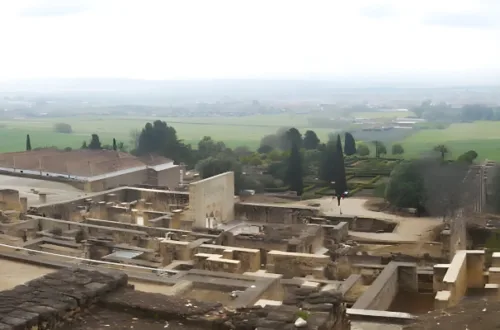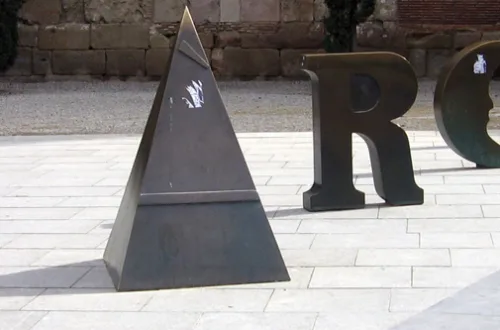
Exploring Roman Corduba: An Art Historian’s Guide to a One-Day Self-Guided Walking Tour of Córdoba’s Ancient Wonders
In the sun-drenched lands of Andalusia, the city of Córdoba rises like a historical phoenix, its ancient Roman roots intertwining with Islamic and Christian threads to weave a rich tapestry of culture.
This comprehensive guide, meticulously curated by an art historian (aka: me), is an invitation to step back in time through a self-guided walking tour. Discover the enduring legacy of Roman Corduba in a single day, immersing yourself in its enduring art, history, and culture.
- Córdoba's Coordinates: A Crossroads of Civilizations
- Chronicles Set in Stone: The History of Roman Corduba
- A Day Among Ruins and Relics: Your Self-Guided Walking Tour of Córdoba
- Craft Your Adventure: A Self-Guided Walking Tour of Roman Córdoba, Spain
- 1. The Roman Bridge: Start your Self-Guided Walking Tour of Córdoba with a UNESCO site
- 2. Puerta del Puente: The Gateway to Roman Córdoba on Your Self-Guided Tour
- 3. Explore the Commercial Plaza and Wall by the Roman Bridge in Córdoba
- 4. Alcázar of the Christian Monarchs (mosaics): Encounter Roman artistry amidst the echoes of later epochs.
- 5. Wall in Parking La Mezquita: Discover history hidden in plain sight near Córdoba's famed Mosque-Cathedral.
- · An Honorable Mention: The Roman Aqueduct at Puerta de Sevilla
- 6. Sewers and Roadway on Antonio Maura Street: Discover Roman Engineering on Your Self-Guided Walking Tour in Córdoba, Spain
- 7. Discover the Majestic Amphitheater of Córdoba on Your Self-Guided Walking Tour of Córdoba
- 8. Archaeological Site of Cercadilla: Embark on an optional excursion to these outlying testaments of Roman domesticity and power.
- 9. Discover Roman Engineering on Your Self-Guided Walking Tour of Córdoba
- 10. Mausoleums and Roman Road: Reflect on mortality and movement at these funerary monuments beside well-trodden paths.
- 11. Roman Termae (Baths): A Window to Ancient Life on Your Self-Guided Walking Tour in Córdoba
- 12. Discover the Heart of Roman Córdoba: The Forums
- 13. The Spectacle of the Roman Theatre (Archaeological Museum) on Your Self-Guided Walking Tour in Córdoba, Spain
- 14. Roman Temple of Córdoba: Your One-Day Self-Guided Walking Tour commences at this once-sacred site.
- 15. Discover the Ancient Roman Domus at Hotel Hospes Palacio del Bailío on Your Self-Guided Walking Tour of Córdoba, Spain
- 16. Hypogeum of the Diputación de Córdoba and Hypogeum on Bodega Street
- 17. Discover the Roman Villa of Santa Rosa on Your Self-Guided Tour of Córdoba
- Best Times to Embark on a Self-Guided Walking Tour of Córdoba, Spain
- Planning Your Stay: Immerse Yourself in Roman Córdoba
“Ruins, for me, are the beginning. With the debris, you can construct new ideas. They are symbols of a beginning.”
— Anselm Kiefer
Córdoba’s Coordinates: A Crossroads of Civilizations
Situated along the serene Guadalquivir River, Córdoba‘s strategic location has been prized since antiquity. Once a cornerstone of Roman governance in Hispania and a nexus of Islamic scholarship and power, today’s Córdoba offers a labyrinth of historical narratives waiting to be unraveled.
Córdoba’s allure lies not just in its monumental landmarks, but in the silent stories etched into its very stones. From the Roman foundations to the intricate Moorish artistry and the echoing halls of Christian monuments, Córdoba is a living museum where every alleyway and arcade tells a story.
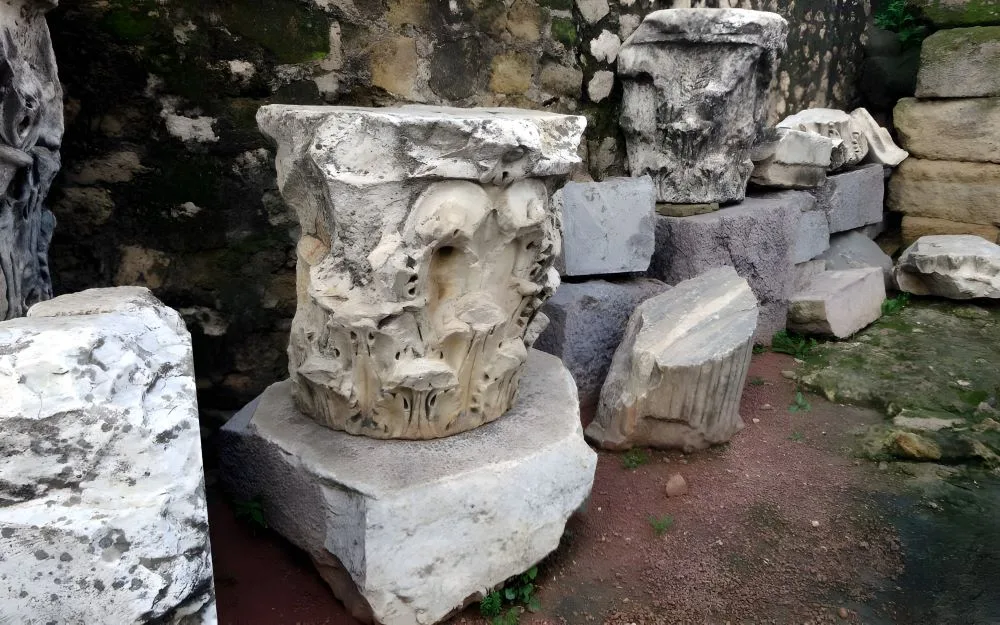
Chronicles Set in Stone: The History of Roman Corduba
The saga of Roman Corduba began in the 2nd century BC. After their triumph over the Carthaginians, the Romans laid the city’s first stones. And so, Corduba soon became a pivotal city in Hispania.
Furthermore, in 45 BC, Julius Caesar, following his victories, settled his veterans from the Tenth Legion in the city. He christened their new home “Colonia Patricia”. This influx of seasoned soldiers and their families spurred a population surge and cemented Corduba’s status as a preeminent Roman city.
By 27 BC, Emperor Augustus had reshaped the empire. He turned his attention to Hispania, and Corduba emerged as the capital of Baetica. The city underwent a swift and grand transformation. Temples dedicated to the gods and the imperial family rose. The forum buzzed with life—here, Corduba’s citizens engaged in trade, politics, and justice.
The Roman Bridge, an engineering marvel, was constructed in the 1st century BC. It spanned the Guadalquivir, linking Corduba to distant lands. This bridge was not just a means of crossing; it was a testament to Roman power and ingenuity.
Córdoba’s Roman Legacy: From Seneca’s Wisdom to Visigothic Rule
Corduba’s streets teemed with scholars and poets. The philosopher Seneca pondered life’s complexities, while the poet Lucan crafted words into epic narratives. The city’s cultural scene was as vibrant as its economy, which thrived on olive oil and garum production. This fish sauce was a culinary staple, and Corduba’s rendition was celebrated throughout the empire.
As centuries passed, Rome’s dominion waned. By the 3rd century AD, Rome’s grip had weakened. Germanic tribes pressed in, and the Visigoths eventually claimed Corduba in the 5th century, marking a new chapter in its history.
Today, Córdoba offers a portal into its Roman heritage. The ruins of temples and the ancient bridge stand as silent witnesses to its former glory. They serve as reminders of a time when Corduba was not just a bustling metropolis, but also a beacon of Roman civilization in all its complexity and magnificence.

A Day Among Ruins and Relics: Your Self-Guided Walking Tour of Córdoba
Embark on a journey through time as you wander the evocative streets of Córdoba, a city where the whispers of the past are etched into every stone. This meticulously crafted itinerary is your key to unlocking the secrets of ancient Roman Corduba, a place where history is not just remembered, but vividly alive. From the soaring columns of long-forgotten temples to the bustling life of the Roman forum, each step will take you deeper into the heart of an empire that once spanned continents.
As you navigate between ruins and relics, you’ll trace the footsteps of senators, soldiers, merchants, and philosophers who once called this city home. Your path will lead you along the Republican Wall, through the Gate of the Bridge, and across the magnificent Roman Bridge of Córdoba itself—a marvel of ancient engineering.
This self-guided tour is more than a simple walk; it’s an immersive experience. You’ll stand where gladiators clashed in the amphitheater’s sandy arena, reflect on the communal spirit within the Roman Baths, and marvel at the intricate mosaics in the Alcázar of the Christian Monarchs.
Craft Your Adventure: A Self-Guided Walking Tour of Roman Córdoba, Spain
Embark on an unforgettable self-guided walking tour through Roman Córdoba, Spain. This journey is yours to tailor. Feel free to shuffle the order of sights to suit your pace and what fascinates you most.
· Kick-Start Your Day in Comfort
Get an early start to make the most of your day. Comfortable footwear is a must – you’ll be on your feet exploring the wonders of Córdoba from sunrise to sunset.
· Hidden Gems in Modern Settings
Córdoba’s ancient ruins are nestled within contemporary structures. Remember to check when they’re open. This way, you won’t miss out on any hidden treasures.
· Stay Energized and Hydrated
Pack snacks and water for your tour. Staying hydrated is key, especially as you lose yourself in the charm and history of Roman Córdoba. Enjoy every step of your journey!
1. The Roman Bridge: Start your Self-Guided Walking Tour of Córdoba with a UNESCO site
As you map out your self-guided walking tour of Córdoba, Spain, the storied Roman Bridge is a must-visit landmark. More than just a crossing over the Guadalquivir River, this bridge is a living testament to the enduring legacy of Roman Córdoba.
Also known as the Old Bridge, it was for two millennia the sole bridge in the city. Picture yourself strolling the same path once trodden by ancient Romans, Moors, and travelers from across centuries.
A Living Monument of Roman Córdoba
Designated a Site of Cultural Interest and part of a UNESCO World Heritage Site, the bridge offers a direct connection to history. Spanning 331 meters with 16 arches, it stands as a silent witness to the passage of time and tales untold.
As you walk across the bridge, feel the echoes of history with each step. Reflect on Julius Caesar’s troops forging a river crossing, the Islamic reconstructions, and the countless travelers who entered the city through this very gateway.
On your self-guided walking tour through Córdoba, Spain, the Roman Bridge is an essential stop. It bridges not just two riverbanks but also connects the present to a glorious past. Embrace the pedestrian journey and delve into the history of Roman Córdoba.
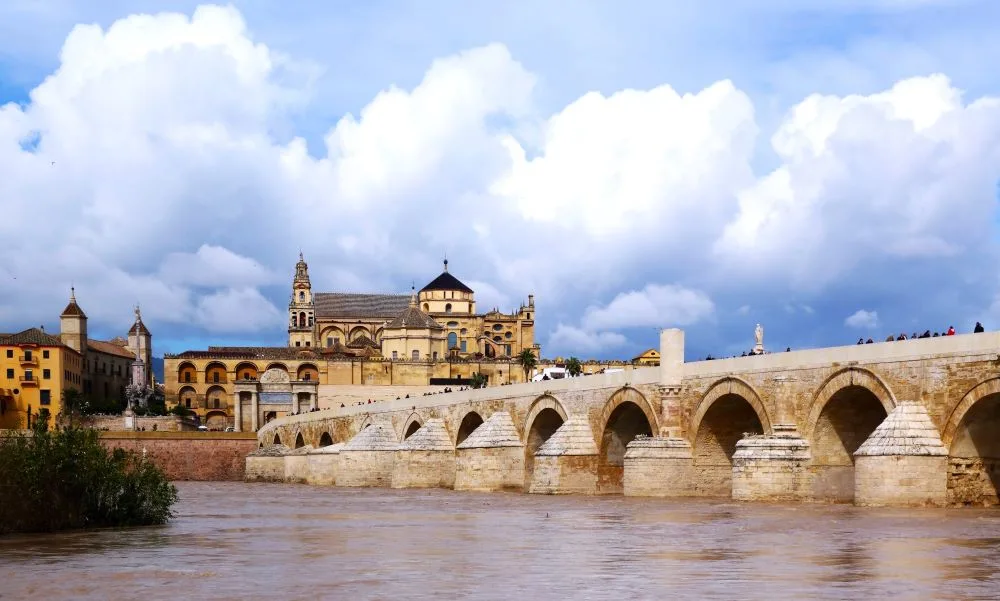
2. Puerta del Puente: The Gateway to Roman Córdoba on Your Self-Guided Tour
Embark on a captivating journey through time as you include the Puerta del Puente on your self-guided walking tour of Córdoba, Spain. This historic gate serves as a grand entrance to the city’s Roman past, standing proudly at the end of the Roman Bridge.
As you approach the Puerta del Puente, imagine the countless travelers who have passed through this gateway over the centuries. Built in the 16th century to honor King Felipe II’s visit, the gate sits where Roman and Moorish portals once welcomed visitors into Córdoba.
A Renaissance Gem in Roman Córdoba
The Puerta del Puente, a Renaissance masterpiece, marks a pivotal point in your exploration of Roman Córdoba. It’s not just a gate; it’s a symbol of the city’s evolution from its ancient roots to a modern hub.
Originally constructed with three arches during the reigns of Roman Emperors Tiberius and Claudius, the gateway was crucial due to its proximity to the Guadalquivir River. It gained prominence in Islamic times, safeguarding the mosque and the Andalusian Alcázar.
In the 16th century, the city authorities decided to replace the old gate with something grander. It was a main entrance to the city, bustling with people and supplies. The goal was to enlarge and beautify it, reflecting the city’s pride and aesthetic aspirations.

3. Explore the Commercial Plaza and Wall by the Roman Bridge in Córdoba
Dive into the heart of Roman Córdoba with a self-guided walking tour that takes you to the remarkable Commercial Plaza near the Roman Bridge. Picture yourself stepping off the ancient bridge and being welcomed by an imposing gateway, now “Puerta del Puente” a sixteenth-century addition standing where a Roman gate once did.
This plaza was a bustling mercantile center, partially enclosed by the protective arms of the city’s walls. In what is now the Visitor Reception Center of Córdoba, you have a unique opportunity to witness the remnants of these walls and the foundations of long-gone shops and stalls.
Large basins, which played a crucial role in the city’s olive oil trade, are still visible, illustrating the plaza’s commercial significance and its synergy with the Guadalquivir River’s port.
Initiated in the days of Emperor Claudius around the first century, this marketplace was teeming with activity, facilitating trade and social interaction. Today, models, displays, and ample information bring this distant past to life. Visiting this site is essential for anyone interested in gaining a comprehensive understanding of Córdoba’s Roman heritage.
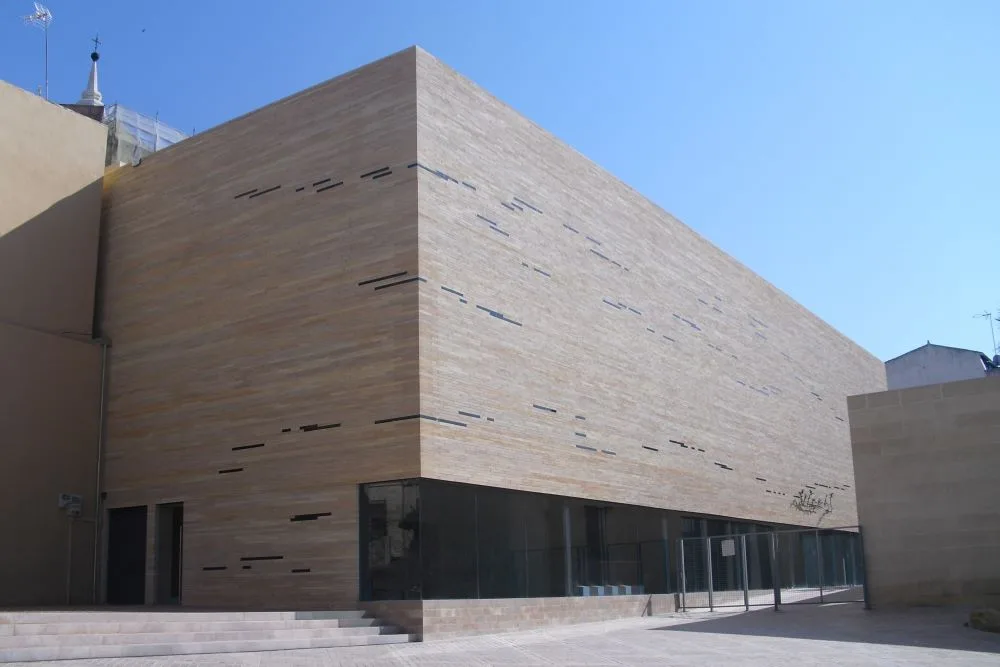
4. Alcázar of the Christian Monarchs (mosaics): Encounter Roman artistry amidst the echoes of later epochs.
In the heart of Córdoba, Spain, on your self-guided walking tour, the Salón de los Mosaicos is a must-see. This majestic room within the Alcázar de los Reyes Cristianos is a treasure trove of Roman-era artistry. The mosaics, once part of opulent Roman villas, now grace the walls of the Alcázar’s most regal hall.
The journey through the Alcázar begins with historical artifacts like the Roman sarcophagus and the bust of Seneca. These lead you to the Mosaic Salon, originally a chapel during the Inquisition, later transformed into a prison chapel, and now a space for public events and civil marriages.
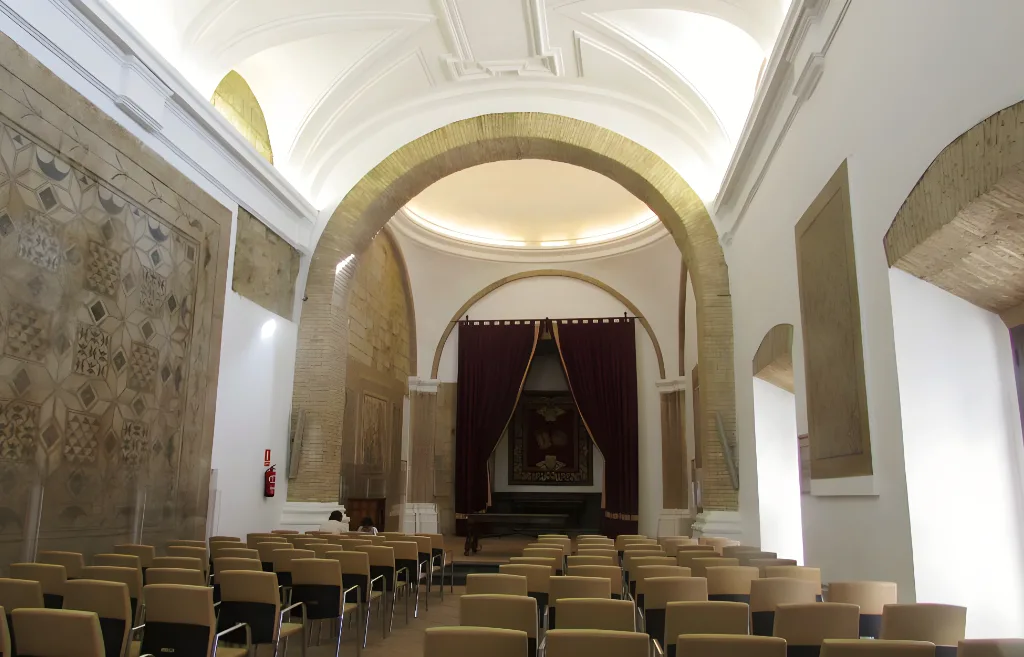
Roman Córdoba Mosaics That Tell Ancient Stories
The salon showcases seven mosaics, each a window into life in Roman Córdoba. The most prominent mosaic, which likely adorned a grand Roman home’s courtyard, depicts Polyphemus and Galatea. It captures the cyclops mid-declaration of love, surrounded by intricate geometric patterns.
Upon entering the salon, you’re greeted by the Eros and Psyche mosaic. This piece illustrates the love story from Apuleius’s “The Golden Ass,” complete with allegorical representations of the seasons.
Part of a mosaic known as “The Garland” is on display, its incomplete state inviting visitors to imagine its original splendor.
As you plan your visit to Córdoba, make sure to include the Alcázar de los Reyes Cristianos and its captivating Salón de los Mosaicos. For those seeking more in-depth insight, consider a guided tour to fully appreciate the historical and cultural context of these ancient artworks.
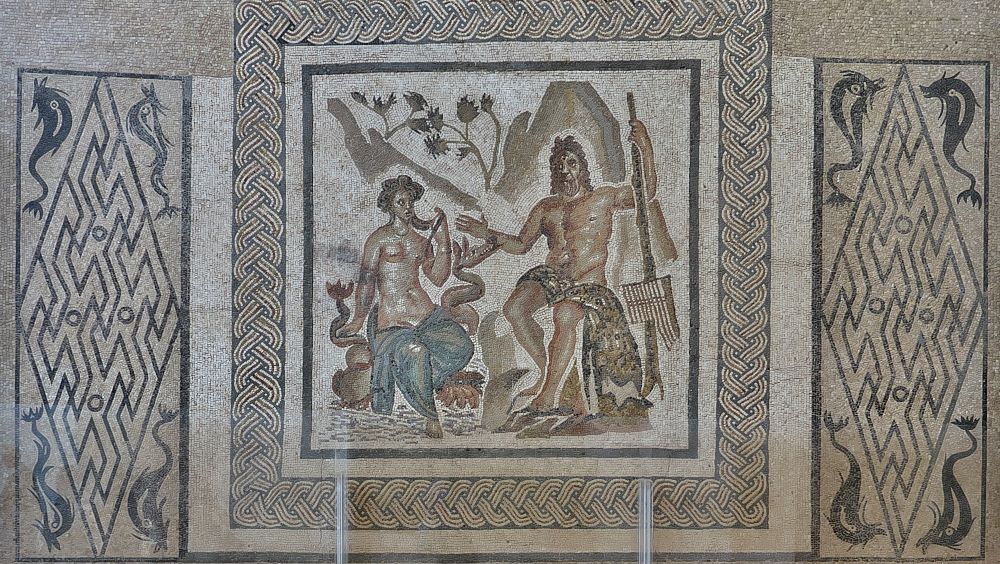
5. Wall in Parking La Mezquita: Discover history hidden in plain sight near Córdoba’s famed Mosque-Cathedral.
As you embark on your self-guided walking tour in Córdoba, Spain, prepare to uncover layers of history that lie beneath the bustling streets. Just a stone’s throw from the iconic Mosque-Cathedral, the Parking La Mezquita offers more than a space for your car. It’s a gateway to the past.
Imagine parking your car and stumbling upon an ancient Roman wall. This is precisely what awaits in the heart of Córdoba. The wall, a silent sentinel, stands as a testament to Roman Córdoba’s grandeur.
A Self-Guided Walking Tour Back in Time to Roman Córdoba
Short steps from the Mosque-Cathedral, this wall is not just another structure. It’s a piece of history, hidden in plain sight. It tells a story of a city that has thrived for centuries.
As you wander through this city, let the wall in Parking La Mezquita remind you of the rich tapestry that is Córdoba. The Romans left their mark here, and now, you walk in their footsteps.
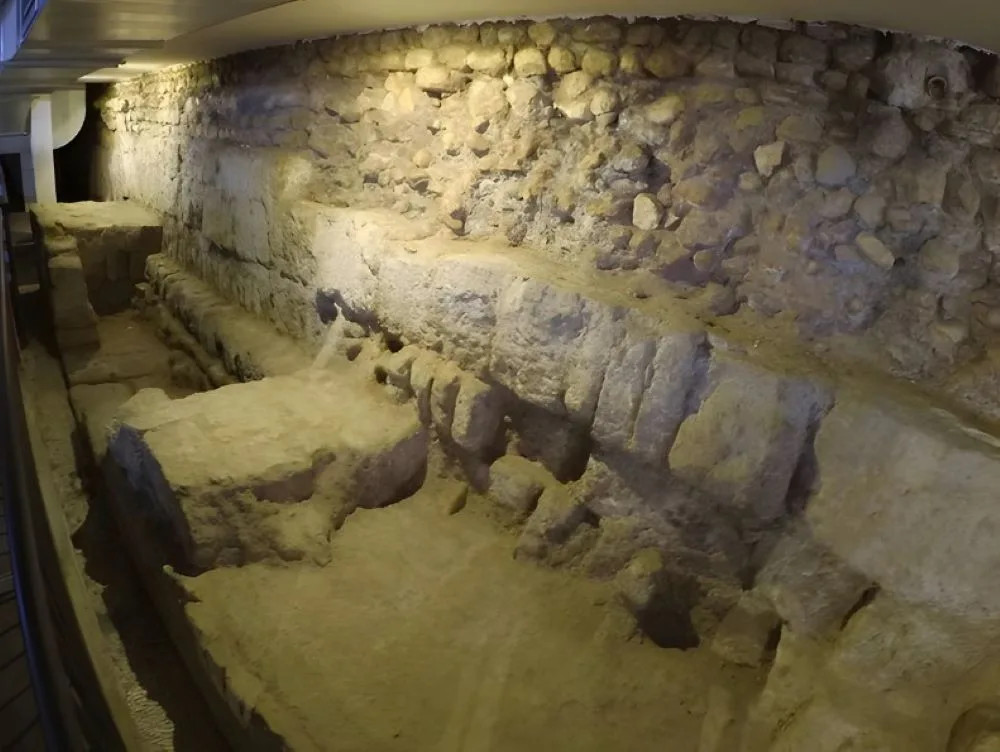
· An Honorable Mention: The Roman Aqueduct at Puerta de Sevilla
On your self-guided walking tour of Córdoba, Spain, a pivotal landmark to explore is the Puerta de Sevilla. This 14th-century gate, part of Córdoba’s western walls, holds a Roman secret: the remnants of what may have been an aqueduct.
As you approach the Puerta de Sevilla, direct your gaze to the small tower structure beside it. Recent research suggests that this might be part of an ancient Roman aqueduct, an engineering marvel that once supplied water to the bustling city.
The presence of this aqueduct underscores Córdoba’s significance during the Roman era. Picture water flowing through this structure, essential to the city’s vibrancy. Today, its remains stand as a silent testament to Roman ingenuity.
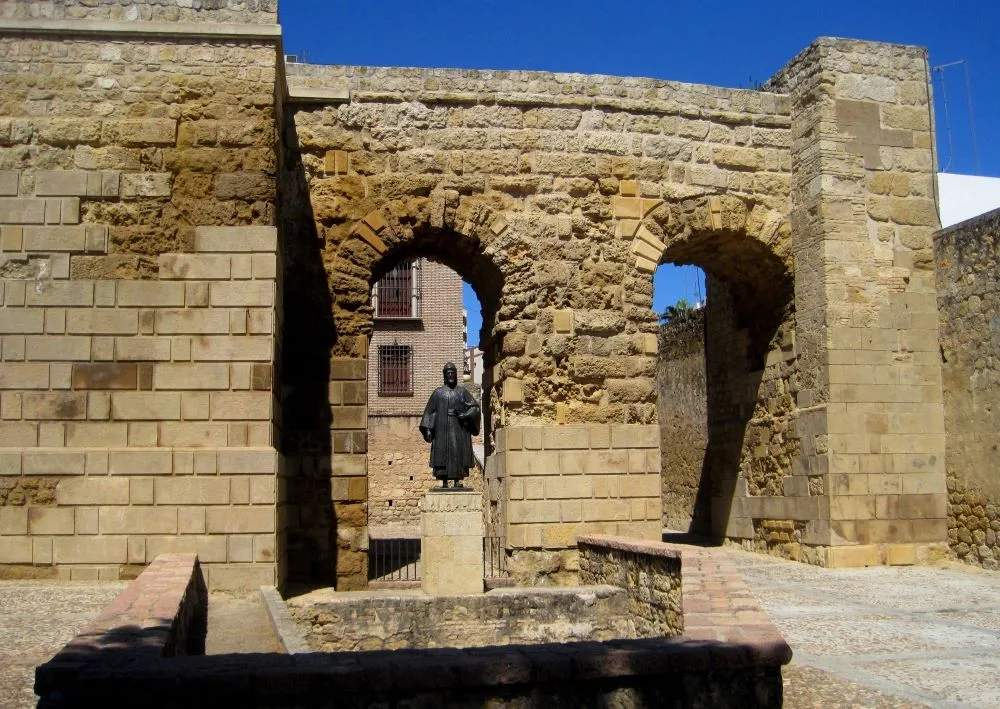
6. Sewers and Roadway on Antonio Maura Street: Discover Roman Engineering on Your Self-Guided Walking Tour in Córdoba, Spain
Embark on a captivating self-guided walking tour in Córdoba, Spain, and delve into the depths of Roman engineering. Your path leads to the remarkable Roman sewers of Antonio Maura Street, an underground marvel that tells a story of ancient innovation.
In the heart of Roman Córdoba, beneath the modern streets, lies a network of cloacas, or ancient sewers. Some structures lie in the parking of an apartment block, accessible from what is now called Secretary Carretero Street, number 11.
They showcase the Romans’ advanced approach to urban planning. As you explore, imagine the bustling life above these subterranean channels centuries ago.
The site became known when a building was demolished, revealing a complex system beneath. It stood open for study and public view, displaying a tangle of stonework and cleaning registers. The cloacas were part of a larger public building, likely related to the amphitheater, ensuring efficient water drainage.
A Glimpse into the Past of Roman Córdoba
Today, you can see sections of these sewers cut into the walls at different levels. The street covering them was wide, a thoroughfare for Cordobans heading to their leisure at the amphitheater. In these sections, you can spot the debris that eventually filled the sewers, left untouched as time passed.
While the conservation may not be perfect, it’s a joy to still have access to such historical wonders. Though visits are limited due to staffing, even a trickle of opportunity to see these sites is valuable. It’s like a dripping tap of history, offering us rare glimpses into our shared past.
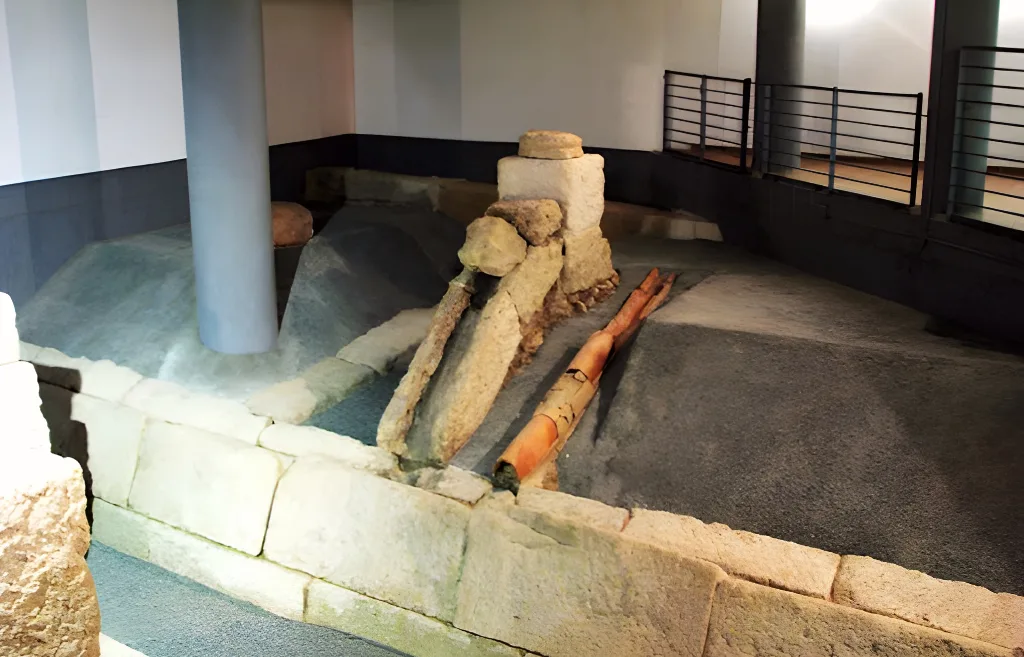
7. Discover the Majestic Amphitheater of Córdoba on Your Self-Guided Walking Tour of Córdoba
Embark on a self-guided walking tour in Córdoba, Spain, and you can’t miss the Anfiteatro de Córdoba. This ancient amphitheater, a testament to Roman Córdoba’s grandeur, was once the largest in Hispania. Today, it stands as a monumental reminder of the city’s imperial past.
Imagine stepping into an arena where gladiators once clashed. Built in the 1st century, the Anfiteatro de Córdoba was a marvel of its time.
It was even larger than the famed Colosseum in Rome when first constructed. Up to 40,000 spectators could gather here to witness the spectacle of ancient games.
The amphitheater’s elliptical shape and massive stone foundations supported rows upon rows of seating. Measuring 178 meters at its longest and 140 meters at its shortest, it was designed to awe. The structure was divided into three main sections, each tier offering a different view to the bustling crowds.
From Glory to Ruins: The Amphitheater’s Fate
After thriving for centuries, the amphitheater fell into disuse by the 4th century. Over time, its stones were plundered, repurposed for newer constructions. Yet, its outline remains, buried beneath the city’s layers.
It wasn’t until 2002 that archaeologists confirmed the site as the Anfiteatro de Córdoba. Before then, its exact location was a mystery. The discovery was monumental, providing a direct link to the city’s vibrant Roman heritage.
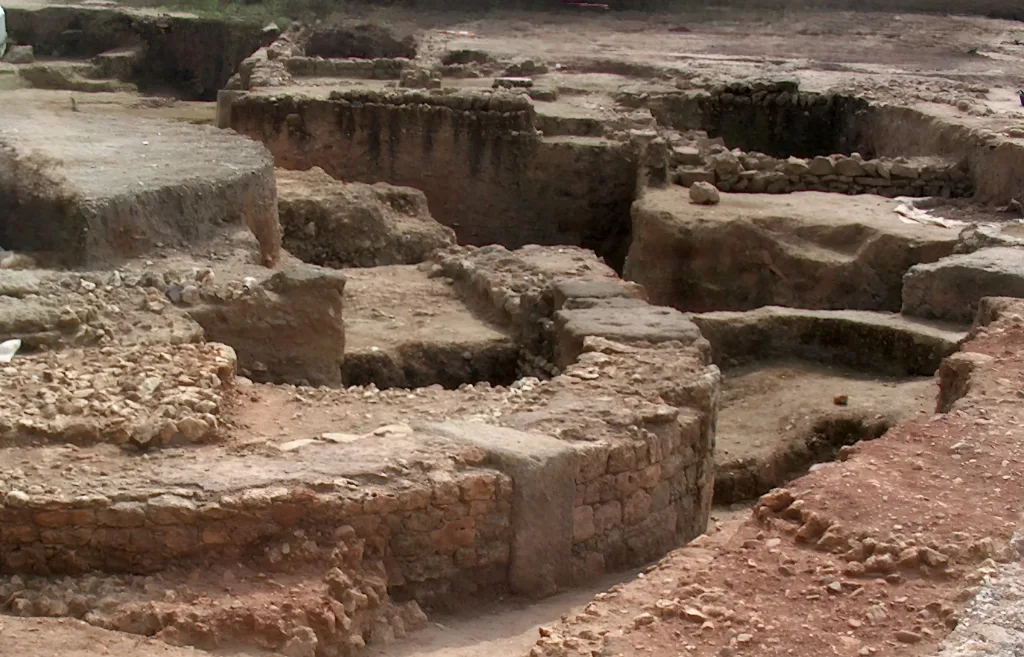
8. Archaeological Site of Cercadilla: Embark on an optional excursion to these outlying testaments of Roman domesticity and power.
Embark on a self-guided walking tour of Córdoba, Spain, and don’t miss the chance to uncover the layers of Roman Córdoba at the archaeological site of Cercadilla. Discovered in phases, first in 1922 and then more extensively in 1991, this site has yielded a treasure trove of late Roman and early medieval history.
While you navigate the modern streets of Córdoba, take a detour to where the remnants of a grand architectural complex emerged. Built in the late 3rd century, it’s believed to have been commissioned by Emperor Maximian during his reign in the tetrarchy.
Witness Roman Grandeur Amidst Modern Córdoba
The visible ruins include the palatial complex of Maximian Herculeus, showcasing the urban sophistication and architectural ingenuity of the time. As you explore, picture the construction process of this palace, right down to the opus vittatum mixtum basin used for mixing concrete for the walls.
Among the relics are the remains of the Aqua Fontis Aureae aqueduct and caliphal houses, offering a tangible connection to Córdoba’s illustrious past. The cistern from the palace’s service area, now relocated for preservation, stands as a testament to Roman engineering prowess.

9. Discover Roman Engineering on Your Self-Guided Walking Tour of Córdoba
As you embark on your self-guided walking tour through Córdoba, Spain, prepare to be captivated by the ancient city’s marvels. Among these wonders are the aqueducts, masterpieces of Roman engineering that once quenched the city’s thirst.
The Aqua Vetus, Aqua Augusta, and Aqua Nova Domitiana Augusta stand as testaments to Rome’s ingenuity. The Aqua Fontis Aureae, another feat of Roman construction, still whispers tales from the past. Pause and marvel at these remnants that once coursed with life-giving water.
Witness the Legacy of Rome’s Waterworks
As you trace the routes where water once flowed, imagine the Roman city in its prime. These aqueducts weren’t just functional; they were symbols of prosperity and technological prowess.
Your walking tour isn’t just a stroll through present-day Córdoba; it’s a journey through time. Each step brings you closer to understanding the grandeur of Roman Córdoba. So, keep an eye out for these ancient waterworks—they’re key chapters in the city’s storied past.
Remember, as you wander, that these aqueducts are more than stone and mortar. They are enduring legacies of a civilization that continues to shape our world. Make sure to include them in your exploration for a truly immersive experience of Roman Córdoba.

10. Mausoleums and Roman Road: Reflect on mortality and movement at these funerary monuments beside well-trodden paths.
Embark on a captivating segment of your self-guided walking tour through Córdoba, Spain, and stumble upon the Roman Mausoleums. Nestled in the serene Jardines de la Victoria, these cylindrical monuments stand as silent witnesses to the city’s rich Roman heritage.
As you wander through the lush gardens, let your curiosity lead you to these ancient burial sites. Constructed in the 1st century, the mausoleums flank the Via Augusta, the very road that connected Córdoba to Hispalis (now Seville).
Unveiling the Secrets of the Roman Mausoleums
The northern mausoleum, possibly the final resting place of a patrician, and its southern counterpart, a columbarium for his relatives, offer a glimpse into familial and social structures of the time.
These structures were part of a necropolis that later gave way to a residential area near Corduba’s amphitheater, only to return to its original funerary purpose by the 3rd century.
Furthermore, these mausoleums are unique in the Iberian Peninsula for their design, possibly crafted by an Italian architect. Their grand size implies they belonged to a wealthy family. During your visit, marvel at the remnants of the funerary chamber, the base, and the battlemented parapet.
A Glimpse into Architectural Grandeur
Marvel at the 13-meter diameter of these funerary monuments, noting the burial chamber that once housed cinerary urns. The remains of the base, cornices, and crenellated parapet are still visible, showcasing the opulence that befitted an affluent family.
The Roman law that mandated burials outside city limits next to thoroughfares is exemplified here. Walk alongside what was once the bustling Via Augusta, exiting through the western gate or “Porta Principalis Sinistra” (formerly known as Gallegos gate). You can even spot original pavement fragments from that era within this archaeological ensemble.
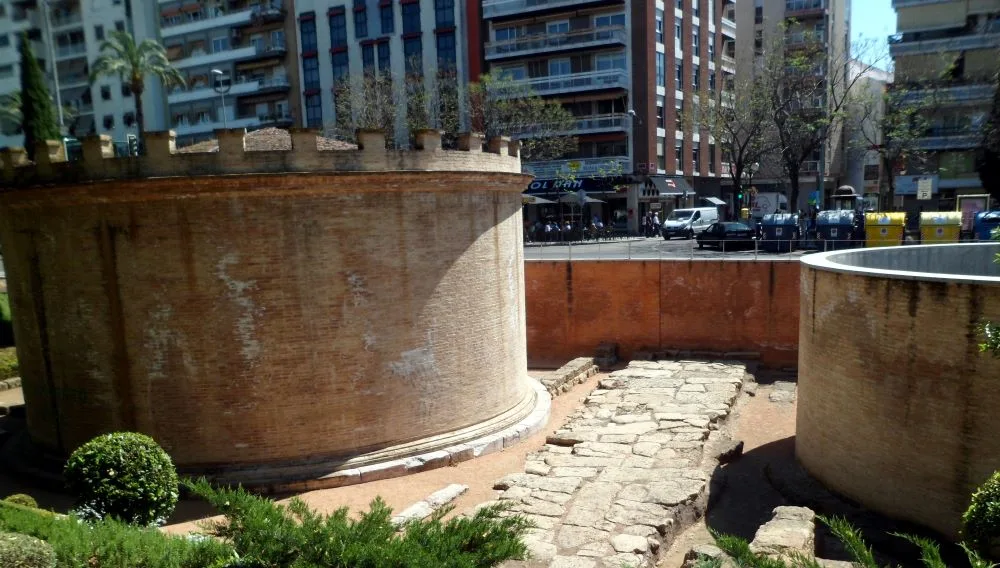
11. Roman Termae (Baths): A Window to Ancient Life on Your Self-Guided Walking Tour in Córdoba
Embark on a self-guided walking tour in Córdoba, Spain, and step into the world of Roman Córdoba. Among the city’s hidden gems are the Roman Baths, communal spaces that offer a glimpse into daily life two millennia ago.
In the midst of vibrant streets, discover the Roman Baths, once bustling with locals seeking relaxation and social interaction. These ancient structures tell tales of a society rich in culture and community.
Experience Roman Córdoba Up Close
As you navigate through Córdoba’s historic lanes, the Roman Baths are essential stops. They are not just ruins; they are storytellers. Each room, each mosaic, speaks volumes about the Romans who once walked these grounds.
The baths are more than just a sight to behold; they’re an interactive chapter of history. Imagine the echoes of conversation, the laughter, and the splashing of water that once filled these spaces.

12. Discover the Heart of Roman Córdoba: The Forums
Have you ever imagined walking the same streets that ancient Romans did? In Córdoba, Spain, you can do just that. A self-guided walking tour through the heart of Roman Córdoba is not just a stroll; it’s a leap through history. Let’s unwrap the layers of time in this enchanting city.
So, let’s delve into the story of the forums that defined Roman Córdoba: the Colonial, the Provincial, and the Adiectum.
a) The Colonial Forum: Where Past Meets Present
Our first stop is the bustling Colonial Forum. Once the epicenter of Roman Córdoba, its energy still pulses beneath the modern streets of Cruz Conde and Ramírez de Arellano. Here, the forum wasn’t merely a public space. It was the throbbing heart of the city, resonating with the daily life of its citizens. From its inception, this forum was Córdoba’s focal point, remaining active until the 4th century.
As you walk, picture the ancient Cordobans, their voices mingling with the clatter of carts and footsteps, all echoing across what was once a 7,000 square meter expanse of civic pride.
The forum’s legacy is one of endurance and renewal. After suffering damage at the hands of Julius Caesar’s troops, it was restored to grandeur during Caesar Augustus’s rule. This is not just a chapter from a history book; it’s a real place where you can feel the weight of history beneath your feet.
b) Unveiling the Foro Adiectum: A Key Stop on Your Self-Guided Tour of Roman Córdoba
As you meander through the historic streets, make sure to visit the Foro Adiectum. This site is easily accessible along Calle Morería and forms a part of the present-day College of Lawyers, where the echoes of Roman Córdoba are still visible.
The Foro Adiectum holds a special place in Roman Córdoba. Situated a short walk south from the well-known Colonial Forum, it was designed to support a flourishing community. This space was not just an extension but a strategic enhancement that met the religious, social, and administrative demands of its time.
Imagine standing in a spacious plaza, its ground covered with smooth limestone, overshadowed by a stately temple. The remnants of colossal statues and towering columns give us a glimpse into what the forum once was—a testament to the architectural prowess of ancient Rome.
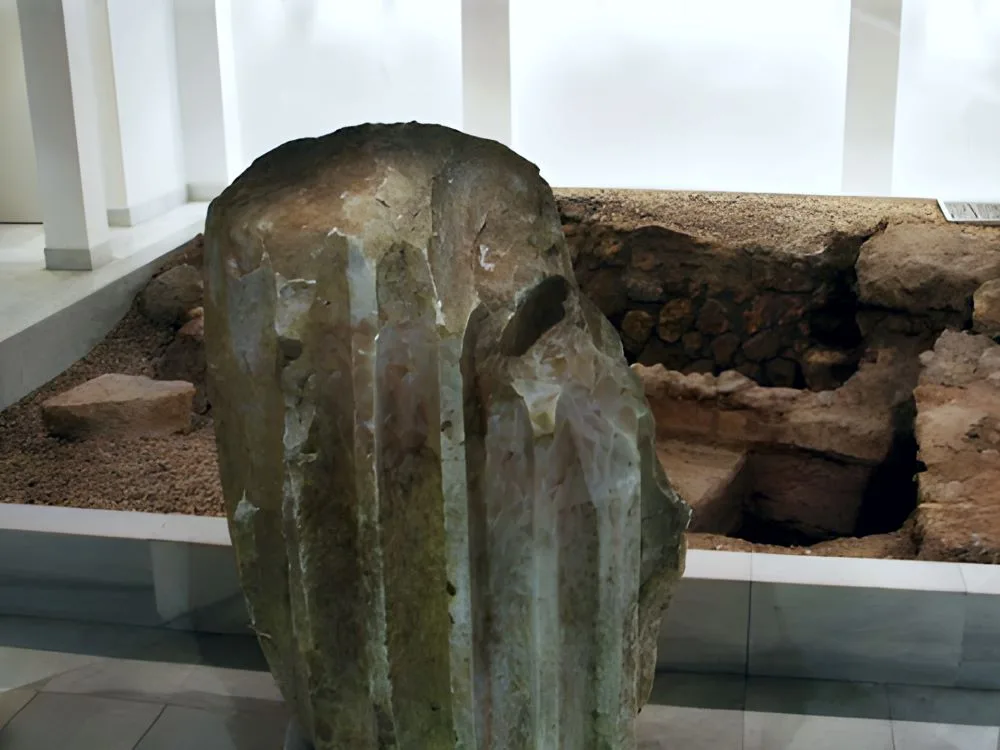
13. The Spectacle of the Roman Theatre (Archaeological Museum) on Your Self-Guided Walking Tour in Córdoba, Spain
If your self-guided walking tour takes you through Córdoba, Spain, a stop at the awe-inspiring Roman Theatre (Teatro Romano) is essential. Tucked within the city’s historic walls, this archaeological marvel lies beneath the modern Museo Arqueológico y Etnológico de Córdoba, inviting you to unearth the grandeur of Roman Córdoba.
Imagine a theatre so vast it was second only to Rome’s own in size. Established during Emperor Augustus’s reign, this monumental site was a testament to Corduba’s significance — the most Romanized city deemed the capital of Baetica. With a capacity to welcome 15,000 spectators, its ruins now whisper tales of ancient entertainment and social gatherings.
Selected for its strategic high ground, the theatre utilized the city’s slopes for its ascending rows of seating. It flourished from the Augustan era well into the 1st century, surviving until the 3rd century when an earthquake struck a devastating blow. Attempts at restoration in the 4th century were foiled by looting and re-purposing of its stones, leading to its eventual concealment beneath residential structures in the Middle Ages.
The Theatre’s Rise and Fall: A Tale of Time
Fast-forward to 1994, when excavations revealed about 30% of the theater, finally bringing its full scale to light. Today, thanks to meticulous restoration efforts, you can visit these remnants and stand where thousands once reveled in dramatic performances.
With a diameter of 124.23 meters, the Teatro Romano’s grandeur is still palpable. Its design cleverly incorporated the natural landscape to support the tiered seating. While some parts remain hidden beneath the museum’s courtyard, others are on display, allowing you to traverse the same steps that once led eager theatergoers to their seats.
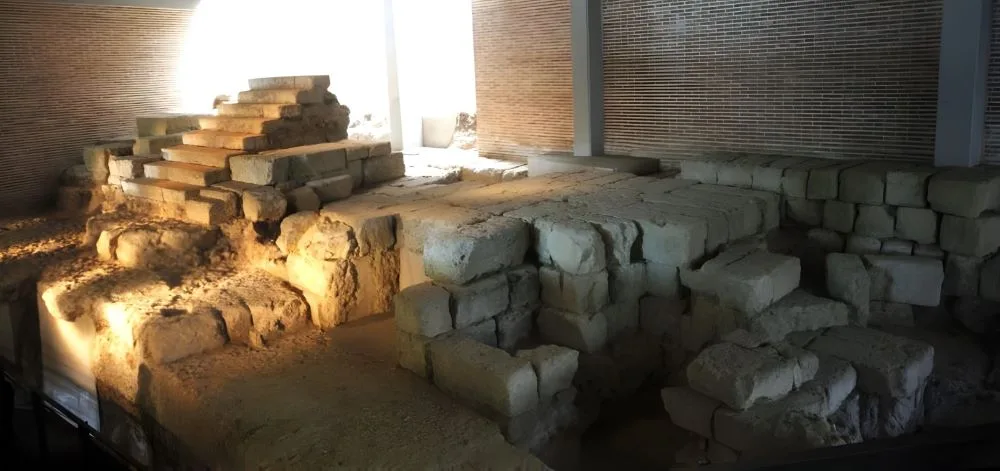
14. Roman Temple of Córdoba: Your One-Day Self-Guided Walking Tour commences at this once-sacred site.
Begin your journey through time in the heart of Spain with the Roman Temple of Córdoba. This temple, a cornerstone of your self-guided walking tour of Córdoba, Spain, was a chance discovery during a city hall expansion in 1951. Located at the bustling crossroads of Claudio Marcelo and Capitulares streets, it stands out as the most significant temple unearthed in the city, revealing the grandeur of Roman Córdoba.
As you approach, the temple’s towering columns instantly command your attention. They are part of a pseudoperipteral design, which gives the illusion of a fully surrounded columned structure. With its hexastyle frontage, featuring six Corinthian columns, the temple showcases ancient Rome’s architectural ambition. These columns, with their intricate acanthus leaf designs, support the structure that once stretched an impressive 32 meters long and 16 meters wide.
From Claudius to Domitian: The Evolution of a Sacred Site
Picture the temple rising from the ground as you stand there. Emperor Claudius laid its foundations between 41-54 AD. Forty years on, Emperor Domitian completed this sacred edifice. It was he who connected the temple to the Aqua Nova Domitiana Augusta, ensuring a supply of fresh water. The 2nd-century modifications to the temple coincide with a shift in urban dynamics, as the colonial forum moved to what we now know as the Convent of Santa Ana.
Recognized as a Cultural Heritage site in 2007, the Roman Temple of Córdoba offers more than just a stop on your itinerary. It’s a portal to the past. As you explore this ancient site, you’re walking on the same ground where Romans once gathered for worship and community events, right in the bustling heart of ancient Córdoba.
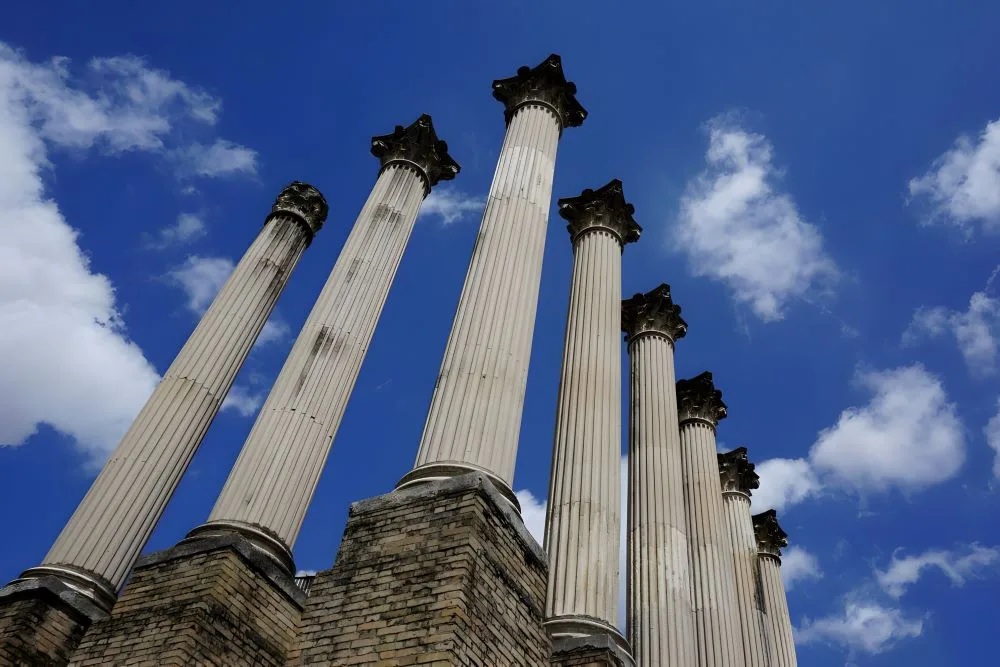
15. Discover the Ancient Roman Domus at Hotel Hospes Palacio del Bailío on Your Self-Guided Walking Tour of Córdoba, Spain
As you embark on your self-guided walking tour of Córdoba, Spain, make sure to visit the Hotel Hospes Palacio del Bailío. Here, nestled within this luxury retreat, lies a remarkable glimpse into ancient Roman life: the remnants of a Roman Domus.
The Roman Domus, a typical house of the ancient Roman elite, offers an intimate look at the domestic life of Corduba’s yesteryears. These ruins, preserved amidst the hotel’s modern amenities, provide a tangible connection to the city’s illustrious past.
The Hotel Hospes Palacio del Bailío has meticulously integrated these ancient ruins into its contemporary setting. Guests can marvel at the architectural wonder while enjoying the comforts of a five-star hotel. It’s a seamless blend of history and luxury.
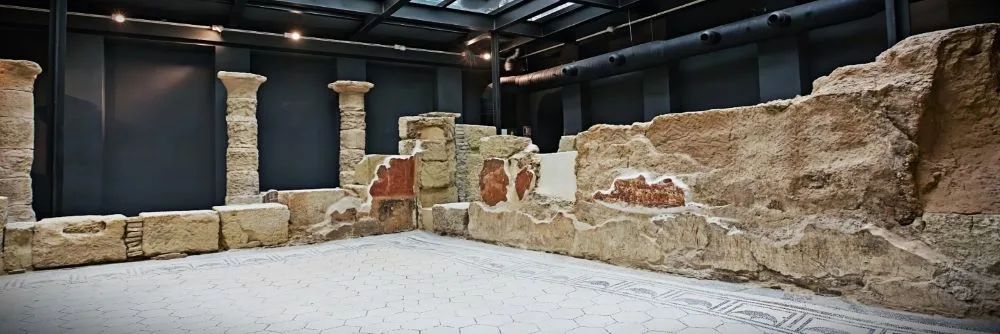
16. Hypogeum of the Diputación de Córdoba and Hypogeum on Bodega Street
Embarking on a self-guided walking tour in Córdoba, Spain, you’ll find hidden gems beneath the city’s bustling streets. The Palacio de la Merced, home to the Provincial Government, invites you to delve into the depths of history. In its basement lies a Roman tomb, a silent witness to the city’s ancient grandeur.
This Augustan-era burial site is a hypogeum, a grand underground chamber reserved for Córdoba’s affluent ancestors. It sits near the Puerta de Osario, at the start of a road that once connected Córdoba to Merida. Here, you can almost hear the echoes of rituals performed in honor of the departed.
The Legacy of Telemachus: A Story Carved in Stone
Near the hypogeum, archaeologists found the tomb stone of Marcus Aerarius Telemachus. As you wander through Córdoba’s streets on your self-guided tour, consider his life. Once a slave, he rose to become a doctor after gaining his freedom. His success is etched into the very stone of his lavish tomb. It’s a powerful reminder of a time when freed slaves could find fortune, but still sought recognition beyond life.
Your self-guided walking tour in Córdoba isn’t just about seeing the sights. It’s about touching history. The tomb, with its Latin cross floor plan and large stone blocks, tells a story of social ascent and personal triumph in Roman Córdoba. It’s an inspiring tale for any visitor, showing how far ambition could take even those born into bondage.
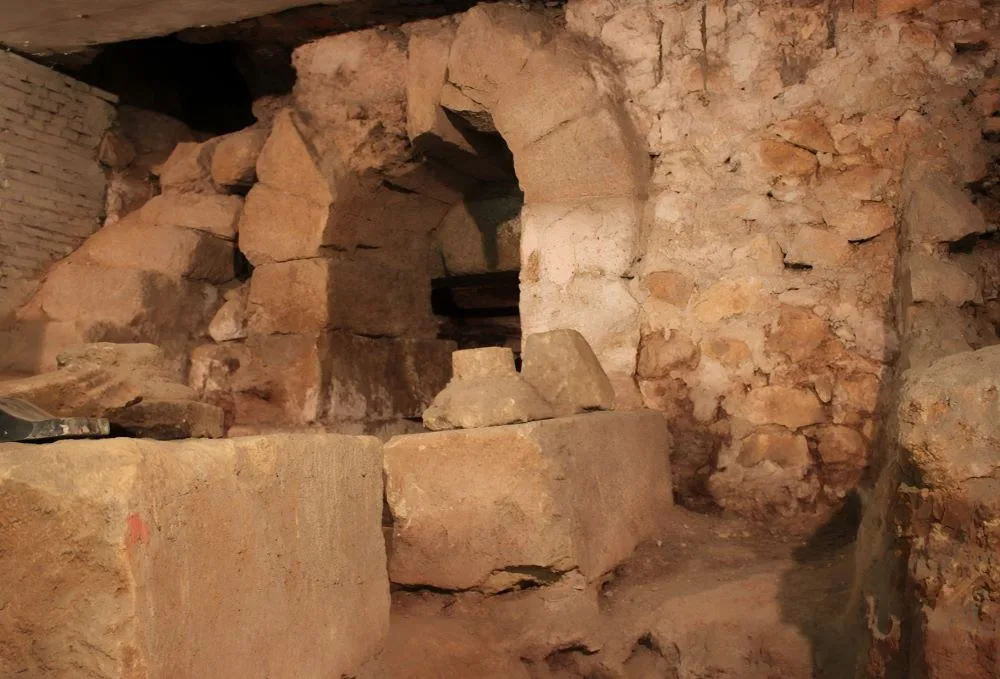
An important note:
Before you start, here’s what you need to know to access the Roman hypogeum at the Provincial Council of Córdoba:
- Simply fill out the online form at Córdoba’s Diputación Electronic Office two weeks before your visit.
- Choose your date and decide if you want the guided tour from the Provincial Council or prefer to explore on your own. Either way, you’re set for an unforgettable dive into Roman history!
17. Discover the Roman Villa of Santa Rosa on Your Self-Guided Tour of Córdoba
As you craft your self-guided walking tour through Córdoba, Spain, be sure to include the Roman Villa of Santa Rosa (also known as San Rafael) on your itinerary. This archaeological site is a testament to the luxurious lifestyle of Roman Córdoba, offering insights into a bygone era of opulence.
Imagine strolling through the peaceful Santa Rosa neighborhood, only to encounter the foundations of a once-grand Roman villa. Dating back to the 2nd century, this site was unearthed in 2003 during construction work on Calle El Algarrobo, revealing a slice of Córdoba’s illustrious past.
Connect with Ancient Roman Córdoba
The Roman Villa of Santa Rosa doesn’t just present ruins; it invites you to piece together the grandeur and sophistication of its former occupants. As you navigate the site, every mosaic and architectural fragment narrates a tale of wealth and cultural richness.
Incorporating the Roman Villa of Santa Rosa into your self-guided tour provides a dynamic history lesson. You’re not merely visiting a location; you’re engaging with the individuals who shaped Córdoba’s history. Each discovery at the villa offers a narrative that breathes life into centuries of Roman daily living.

Best Times to Embark on a Self-Guided Walking Tour of Córdoba, Spain
Planning a self-guided walking tour of Córdoba? The city’s Mediterranean climate is your ally, offering the most pleasant weather during spring and fall. These seasons are perfect for wandering through Roman Córdoba without the extreme heat of summer or the chill of winter.
As flowers bloom in spring and leaves turn golden in fall, Córdoba’s streets call for exploration. These milder months allow for comfortable walks along ancient Roman paths. You’ll enjoy the sun’s warmth without its scorching intensity.
Take advantage of these seasons to meander through Córdoba’s historical treasures. The gentle sun complements your journey through time. It’s the perfect backdrop for discovering the city’s Roman roots at your own pace.
Your Journey Through Córdoba’s Past Awaits
Whether you’re tracing the steps of Roman centurions or basking in the legacy of medieval caliphs, spring, and fall provide the ideal setting. So, lace up your walking shoes and set out on an unforgettable tour through Roman Córdoba. The city’s timeless beauty is enhanced by the season’s perfect embrace.

Planning Your Stay: Immerse Yourself in Roman Córdoba
Considering a self-guided walking tour of Córdoba, Spain? Even if you have just one day, you can capture the essence of Roman Corduba. History buffs, however, may yearn for more time. Extended stays let you delve deeper into the city’s rich tapestry.
A single day in Córdoba can be a whirlwind of discovery. From the ancient bridge to the towering columns, each site tells a part of Córdoba’s Roman story. But remember, these are just glimpses into a complex past.
If time allows, stay longer. Córdoba’s layers of history deserve more than a hurried visit. Each extra day gives you more moments to wander, reflect, and absorb.
Make the Most of Your Córdoba Experience
Whether it’s a quick tour or a leisurely exploration, your journey through Roman Córdoba will be unforgettable. So plan your itinerary, pack your curiosity, and get ready to step back in time. The city’s ancient heart awaits your discovery.
This structured narrative promises to guide readers through an immersive experience, each step on their self-guided tour a stride through centuries, each monument a portal into bygone days. The journey through Roman Corduba is more than a walk; it’s a pilgrimage through time itself.


